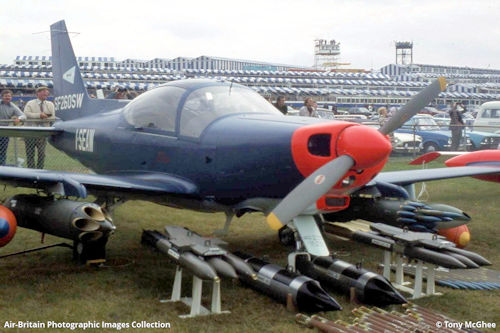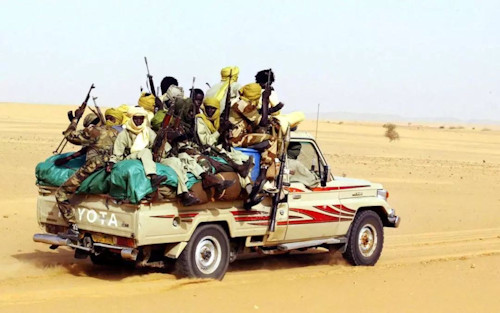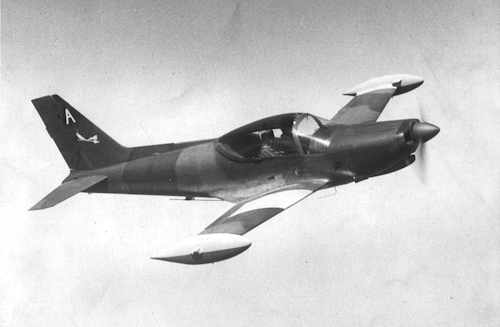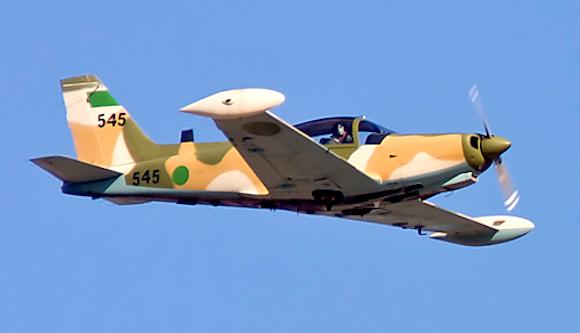Although it was born in the early sixties as a development of another propeller plane, the F.8 Falcon of the engineer Frati who will also design this different model to serve in the field of acrobatic training, the Siai Marchetti SF-260 thanks to the versatility and robustness of its construction cell was immediately considered able to serve even in more purely contexts operational with due structural changes.
For these reasons it was developed a special version for operational use counter-refractory called SF-260W, where W was the initial of the term Warrior which in English means fighter / warrior.
Designed starting from the previous M version, which already allowed the use of war loads through the introduction of special wing beams, the W version for counter-guerrilla and attack operations was designed in such a way as to carry up to 300 kg of rocket launchers, bombs, machine guns , photo pods and launchers.
In turn, incidentally, from the Siai Marchetti SF-260W will be developed the little lucky version for marine patrolling called Sea Warrior equipped with releasable containers containing lifeboats and survival kit at sea.
Given the above, with the diffusion of the SF-260 in the various foreign military air forces since the 70 years as a trainer began also its operational uses in situations of conflict.

The first country to use them in this role was Gaddafi's Libya.
On the long wave of other military supplies, despite the ups and downs of geopolitical relations, Italy provided the strong man of Tripoli also about 240 SF-260 with deliveries that began, approximately, around the 1977.
This large number of Siai Marchetti, acquired both in the W version and in the M version, appropriately modified to operate above the desert areas of the country, hence the designation SF-260WL and SF-260ML where the letter L was - precisely - for " Libya ", was also partly assembled at a special factory built near Tripoli.
Precisely in this place, with all probability, the necessary modifications were made to ensure that these SF-260 could be used by the Libyans: the US avionics used on the aircraft had, in fact, because of the embargo to which it was subjected by the USA at the time, be replaced with a similar French derivation.
All of this, of course, caused a delay in the SF-260's entry into the Libyan Military Aviation which, initially, at least for the first time, was used by the local Aeronautical Academy for the start-up of young cadets.
Soon, however, there will be the actual war use of the SF-260 under the Libyan insignia.
Willing to permanently secure possession of the rich region of the Aozou strip for its uranium deposits, the Libyan colonel, in order to achieve this result, from the second half of the 70s, provided regular political and financial support to his man in the area. .
This man replied to the name of Goukouni Oueddei who had now entered openly in conflict with the local president Felix Malloum, a convinced opponent of the Libyan colonel and supported by the French.
Referring to the fact that the head of state favored in the administration and in the various places of power only the populations of the south and the center of the country to the detriment of those of the north, Oueddei rose against his government using his own militia called Forza Popular Army (FAP).

From the very beginning Libyan support in the form of means was considerable. The columns of the Oueddei militia were largely supported by tanks and APCs of the Libyan army. But even from the air Gaddafi's support came to Oueddei.
A support that, in practice, was also guaranteed by SF-260 armed for the occasion with pods for machine guns, unguided rockets and small bombs. Working closely with the much more powerful Mirage 5 and F.1, as well as with the heavy attack and transport helicopters Mi-25 Soviet, the Italian aircraft accomplished at that time many missions of light attack to support ground troops with excellent results.
For example, with the support of the Mi-25, several SF-260 Libyans had managed to effectively bomb the important Chadian government garrison of Faya the 18.02.1978, located in the north of the country.
The success of the operation was such that the troops there were forced to flee very precipitously leaving the men of Oueddei and the Libyans something like 1500 prisoners.
The success of SF-260 missions also depended, to a large extent, on the lack of real air-defense protection among opposing troops.
Won the war with Malloum, Oueddei became President of the Republic but soon entered a collision course with his own Defense Minister Hissène Habré precisely on the relationship to be held with Libya. The two Chadian politicians and their respective factions thus took up arms.
With the return of hostilities in that tormented land the Libyans also returned using the SF-260 again in the role of light attack also for the precious possibility of using simple unprepared planes.
Unlike what happened previously, however, the intervention of the Italian-made aircraft did not prove to be so profitable.

Although at the beginning the missions of Italian aircraft took place with profit, especially in the north of the country with yet another bombardment of the important area of Faya occupied, this time, by the troops of Habrè in opposition to the forces of Oueddei and the Islamic Legion sent from Gaddafi to support the 15.10.1980, as well as in December of the same year in support of the Libyan artillery in the bombings against the capital of Chadiana N'Djamena which also caused large losses among civilians, things soon changed due to the increasingly massive presence valid anti-aircraft.
In one of these missions, in fact, over the skies of Western Sudan where there were several sanctuaries of the pro Habré rebellion, a SF-260 was shot down near the town of Al Geneina while carrying out a bombing action with another similar aircraft.
Given the situation described above, Oueddei was forced to flee from his Libyan protector with the hope of returning soon.
In a short time Oueddei actually returned, heavily supported by the Libyans who, this time, descended directly into the fray, deploying a large number of vehicles and men.
Once again, our SF-260 could not be missing from the airplanes. SF-260 that, in this last glimpse of the troubled history of the Libyan intervention in the Chad to protect the interests present in the Aozou strip, was signaled above all in the paradoxical - role of war prey and aircraft shot down by the increasingly effective enemy antiaircraft.
The reasons for this state of affairs were multiple.

On the one hand, the difficulties of the desert terrain that did not allow the massive use of much more adequate aircraft for a "real" war situation in direct support to the troops on the ground forced us to use our plane in contexts and with objectives that exceeded his own limited military capabilities, on the other the sloppiness and inability of the Libyan military hierarchy to cope with the concrete situation on the ground where the Chadians knew how to best use their Toyota pick-up columns for rapid and incisive raids against opposing bases and formations.
A clear example of the above was the victorious raid conducted by Toyota's "armed" Chadians equipped with heavy machine guns and MILAN counter rocket launchers, supplied by the French, in January 1987 against the precious Faya stronghold.
After the short but very bloody battle ended, in the hands of Habré's men there were also six SF-260s, as well as various other Libyan military vehicles.
No better fate had the SF-260 employees hastily to identify these fast mobile formations in time and distance.
An unfortunate SF-260 in the accomplishment of this mission was knocked down by the Chadian troops the 19.03.1987 together with a Mi-8 helicopter south of the Libyan outpost of Ouadi-Doum, in Bir Koran, where two battalions had also been ambushed mechanized.
The members of these departments, in total panic, would then run away to the base of Ouadi-Doum, believing that they would gain salvation. But they were wrong.

The Chadian departments led by their commander Hassan Djamous, slipping through the minefields that protected the above-mentioned Libyan outpost, attacked him by surprise, seizing a fundamental success for the course of the conflict.
To no avail was the desperate attempt of some SF-260 and Mi-25 to face the attack by offering close air support to troops in distress: An Italian aircraft and a Russian-made helicopter were inexorably shot down.
At the end of the conflict in the 1987 the Libyans found themselves thus having lost, altogether, for various reasons, the beauty of twelve SF-260, in addition to those captured on the ground by the ruthless Chadian troops under Habré's orders.
Thus ended, quite ingloriously, but not by "his own fault", the first war experience of the SF-260.
But the end of the war between Libya and the Chad did not mark the end of the war career of the aircraft of the Siai Marchetti.
Practically in the same period, still in Africa, but much further south, in Rhodesia precisely, other SF-260s were used in a war context.
In fact, in the 1977, two lots of seventeen SF.260C and fourteen SF.260Ws purchased under the banner of special "teams" to "pick them up" around the world arrived in the country despite the embargo.
These planes will go alongside the Britten Norman Islander, the Aermacchi AL-60, and the Cessna 185 Kiwit already present in that theater to form the famous "Fireforce", also composed by helicopters, in order to provide immediate air support to the Rhodesian troops engaged in the difficult task of defeating the filomarxist black guerrilla present there.
 In this task the SF-260 proved to be worthy of the much more famous and famous jet aircraft in the Rhodesian Air Force.
In this task the SF-260 proved to be worthy of the much more famous and famous jet aircraft in the Rhodesian Air Force.
The task of the close air support and of the light attack on armed guerilla bands will be the task of Siai Marchetti also in Nicaragua. In the South American country, in fact, at the beginning of the 80 years, they came from Libya to the new Sandinista government between four and six SF-260 that were widely used for the whole time of the civil war against the Cons armed and financed by the USA.
With the end of the Cold War and of the East / West opposition there have been no more important war scenarios for the aircraft, apart from the latent anti-guerrilla use in the Philippines of which there is, unfortunately, very little.
Only in the 2011 the Libyan SF-260 returned to fly in war contexts. During the civil war, in fact, it is documented its use as a light bomber fortune in Misrata against the fuel deposits that fell into the hands of the local insurgents.
(photo: web)












